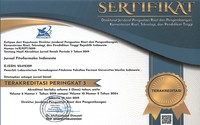Uji Aktivitas Antiplasmodium Dari Isolat Kulit Batang Kayu Tammate (Lannea coromandelica Houtt. Merr.) Secara In-Vitro
Abstract
One of the main causes of death and a major public health problem is malaria. Some drug resistance and the limited number of effective drugs have given the community a sense of worry. This makes the discovery of new antimalarial compounds very necessary. Based on the results of exploration of natural materials, Javanese wood is one of the plants that is efficacious as an antimicrobial and is thought to be efficacious as antiplasmodium. This study was then conducted to find hexan and ethyl acetate isolates from the Java wood fraction (Lannea coromandelica Houtt. Merr.) Which effectively inhibited the development of Plasmodium falciparum in vitro. This research is a follow-up study from previous studies in testing the fraction of Javanese bark against antioxidant activity. The procedure starts from hexan and ethyl acetate isolates with five concentrations of 10 (µg / ml), 1 (µg / ml), 0.1 (µg / ml), 0.01 (µg / ml) and 0.001 (µg / ml) 3D7 strain of Plasmodium falciparum was measured based on the average percent resistance. The results of this study indicate that etil asetat isolate have IC50 2,727 µg/ml, its mean moderate activity as antiplasmodium. While hexan isolate have IC50 >10 µg/ml its mean not have or low antiplasmodium activity.
Keywords
Full Text:
PDF (Bahasa Indonesia)References
Alam, et.all. (2017). Lannea coromandelica (Houtt.) Merr. Induces Heme Oxygenase 1 (HO-1) Expression and Reduces Oxidative Stress via the p38/c-Jun N-Terminal Kinase–Nuclear Factor Erythroid 2-Related Factor 2 (p38/JNK–NRF2)-Mediated Antioxidant Pathway. International Journal Molecular Science, 18(266), 1-18.
Beroa, J. F.-L. (2009). Antimalar ial compounds isolated from plants used in traditional medicine. Journal of Pharmacy and Pharmacology, 61(11), 1401–1433.
Dondee, K. et al.,. (2016). The protective effect of Moringa oleifera leaf extract on liver damage in mice infected with Plasmodium berghei ANKA. Journal of Coastal Life Medicine, 4(9), 742-746.
Desjardins, R. C. (1979). Quantitative assessment of antimalarial activity in vitro by a semiautomated microdilution technique. Antimicrobial Agents Chemother, 16(6), 710-718.
Direktur PPBB. (2014). Pedoman Manajemen Malaria, Direktorat Jenderal Pengendalian Penyakit dan Penyehatan Lingkungan,. Jakarta:: Departemen Kesehatan Republik Indonesia.
Hassan, S. V. (2013). Activity Guided Isolation and Characterization of Antiplasmodial Agents of some Local medicinal Plants. Nigerian Journal of Basic and Applied Science, 21 (3), 177-185.
Kusumaningrum, N. A. (2016). Skripsi Uji Aktivitas Antimalaria Daun Helianthus annus L. dengan Ekstraksi Bertingkatterhadap Plasmodium falciparum secara In Vitro. Surabaya: Fakultas Farmasi Universitas Airlangga Departemen Farmakognosi dan Fitokimia.
Lusiana, H. (2009.). Skripsi Isolation and In Vitro Antiplasmodial Test of Alkaloid Compounds from Albertisia papuana Becc. Bogor: Institut Pertanian Bogor.
Napoleon, S. N. (2009). Efikasi Obat Kloroquin, Kina, Artesunat-SP, Artesunat-Amodiquine, Artesunat-Lumafentrin. 418.
Nursalam Hamzah, N. W. (2017). Growth Inhibition of Plasmodium falciparum and Micobacterium . Journal of Pharmaceutical and Medicinal Sciences, 85-90.
Rudrapal, M. &. (2017). Plant Flavonoids as Potential Source of Future Antimalarial leads. Journal in the field of Pharmacy, 8(1), 13-18.
Tofazzal, M. &. (2000). Dihydroflavonols from Lannea coromandelica. Phytochemistri, 54(8), 901-90.
Wahid, A. (2012). In Vitro Phytochemical and Biological Investigation of Plant Lannea coromandelica (Famili: Anacardiaceae). Bangladesh: Thesis to Departemen Pharmacy East West University.
WHO. (2016). Malaria. Indonesia: Kemenkes.
DOI: https://doi.org/10.33096/jffi.v7i1.591
Copyright (c) 2020 karlina amir tahir

This work is licensed under a Creative Commons Attribution-ShareAlike 4.0 International License.
Indexed by:
ISSN: 2356-0398 | e-ISSN: 2541-2329
Editor's Address:
Third Floor Pharmacognosy-phytochemistry laboratory building, Urip Sumoharjo road km. 5 Campus II UMI, Makassar, South Sulawesi, Indonesia
Phone: +6281524045514
Fax: +62411425619
E-mail: editorjfi@umi.ac.id

















.jpg)

